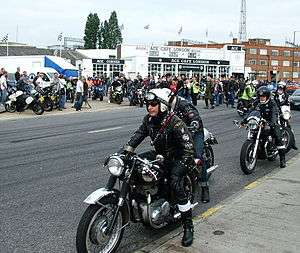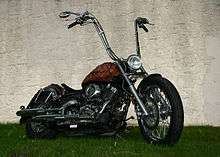Motorcycle handlebar

A Motorcycle handlebar is a tubular component of a motorcycle's steering mechanism. Handlebars provide a mounting place for controls such as brake, throttle, clutch, horn, light switch and rear view mirrors; and they may support part of the rider's weight. Even when a handlebar is a single piece it is usually referred to in the plural as handlebars.[1][2]
Types of handlebar

Handlebars come in a variety of types designed for particular types of riding:
- Beach bars — similar to cruiser bars, slope back toward the rider to allow a relaxed riding position.
- Clip-ons — popular on sport bikes, in which two separate short handles are clamped directly to the fork tubes, rather than to the top of the triple tree. These may be fitted above or below the triple tree, and are easily adjustable.
- Clubman bars — common on cafe bikes. They clamp to the triple tree and are angled backwards to give the rider a more aggressive riding position. In the UK, Clubman bars are also known as "Thruxton bars" or "Ace bars".
- Cruiser handlebars — long and slope towards the rear of the motorcycle so that the rider can sit upright.
- Drag bars — nearly straight across to create a forward-leaning and aerodynamic riding position.
- Motocross bars — motocross and off-road motorcycles have tubular bars with a cross-brace to resist torsional twist. These bars are also found on dual-sport, streetfighter, and supermoto bikes.
- Z-bar — any sharply angled handlebar with either long or short straight rise sections, which are sharply angled upward from the mounting points and again sharply angled to the handgrip and control area.
- "Ape-hangers" — found mainly on choppers, these are handlebars of such exaggerated height that the rider has to reach up to them, hence the name. Fitted for the sake of appearance rather than comfort or safety, they may cause numbness in the hands, but the use of throttle locks or cruise controls[3] may help alleviate such symptoms. Some jurisdictions restrict the maximum height of ape-hangers.[4]
- Buckhorn handlebars — a type of ape-hanger, but shorter and curved (thereby resembling a buck's horn). They are sometimes called "mini-apes" (miniature ape-hangers).
Construction
Handlebars are made from round-section metal tubing, typically aluminium alloys or chrome plated steel but also of carbon fibre and titanium, shaped to the desired contour. Holes may be drilled for the internal routing of control cables such as brake, throttle, and clutch. Risers hold the handlebars above their mounting position on the upper triple tree or the top of the fork, and may be integrated into the bar itself or separate items. Each handlebar end may contain bar-end weights to damp vibration by isolating the bar's resonant frequency from that of the engine. Electrically heated grips may be fitted to provide warmth for the rider in cold weather.
Sizes
There are several size parameters that describe most motorcycle handlebars.
- Width from grip to grip may vary from 30.5 to 37 inches (770 to 940 mm).
- May rise above triple clamp up to 24 in (610 mm) or more, called ape hangers when very high, or may drop a few inches below, called clubman bars.
- Pullback, the distance grips are behind their mounting location, may vary from 4.25 to 17 in (108 to 432 mm).
- Diameters vary; commonly 7⁄8, 1, and 1 1⁄4 in (22, 25, and 32 mm), though oversized bars of 1 1⁄4, 1 1⁄2, and 1 3⁄4 in (32, 38, and 44 mm) may reduce to 1 in (25 mm) at the grips so standard controls may be mounted.
See also
References
- ↑ "handlebar". Oxford English Dictionary (2nd ed.). Oxford University Press. 1989.
- ↑ "Handlebar". Dictionary.com Unabridged. Random House. Retrieved 2015-01-03.
- ↑ Harley Part Number 77196-08 & Part Number 77197-08 depending on model and year
- ↑ http://legis.state.sd.us/statutes/DisplayStatute.aspx?Type=Statute&Statute=32-20-3